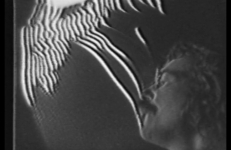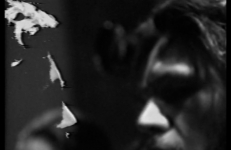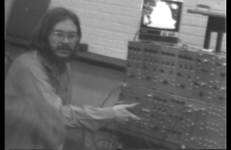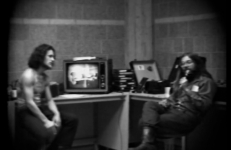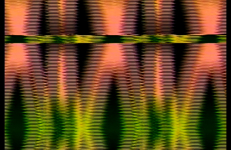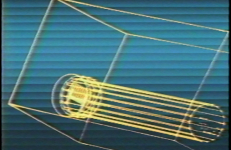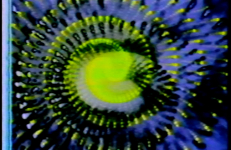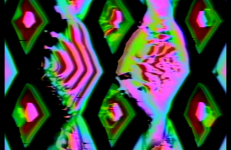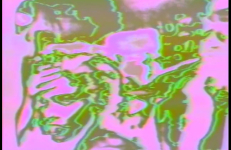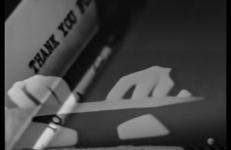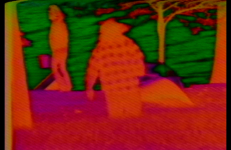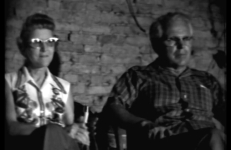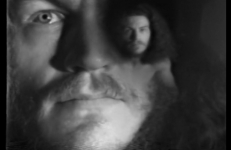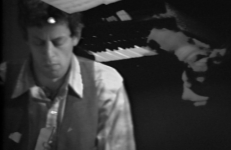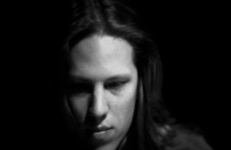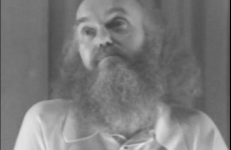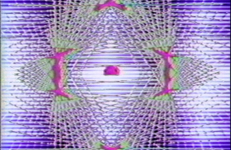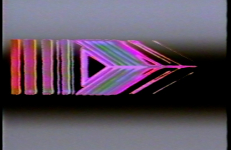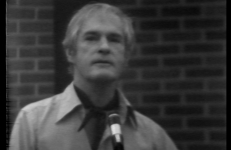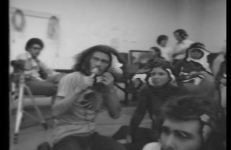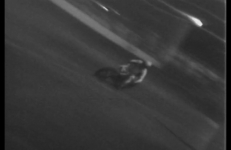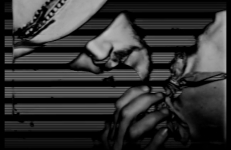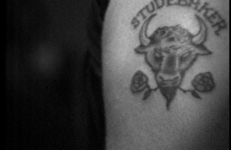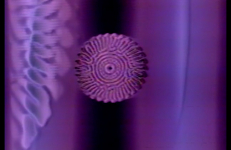Aura of IEVE, edited by Phil Morton, is video documentation of the first Interactive Electronic Visualization Event (IEVE) at the University of Illinois Circle Campus. Unlike IEVE Aura, which features the image processed and audio synthesized video from the event, the camera instead focuses on the artists creating the video: Tom DeFanti on the Digital Keyboard (computer), Dan Sandin on the Image Processor, and Bob Snyder on the sound keyboard.
The Phil Morton Memorial Research Archive
The video opens with visual feedback and various sounds including snoring, whistling, and other generated audio. The video then slowly transitions into Phil Morton’s monologue and a solarized image. Phil is in front of video equipment racks at the Governors State University—a public university in University Park, Illinois. He starts by discussing events at the school, and then draws the viewers’ attention to the video waveform behind him as he sways. He says that “all things in the universe are so interconnected,” and ends up in laughter.
Featuring overlaying monologues, Phil Morton brings up a wide range of philosophical and mundane topics: self-exploration, evolution, personal values, frustration, exhaustion, spirituality, video making, etc. He discusses the capability of video as a tool for expansion of perception.
In this hour-long video, Dan Sandin demonstrates and explains in detail on modules of the Sandin Image Processor. Beginning with a playful and amateurish set up segment, Dan introduces his new invention, which he hints will be duplicated by Phil Morton shortly.
Phil Morton and Dan Sandin introduce video equipment and editing techniques to St. Olaf College students—a private liberal arts college in Northfield, Minnesota. They display constant playful interactions, from deliberately making audio feedback to mimicking the feedback sounds with voice. The workshop is very laid-back and carefree which is typical of the '70s counterculture and DIY Video communities.
Featuring a swirling spiral from video feedback, this video provides a contemplative visual space for viewers. The spiral appears on and off against colorful oscillation patterns.
This video shares a close resemblance with Venn’s Apron, which appears to have been made on the same day: January 1,1973. Compared to Venn’s Apron, which has a seemingly improvised approach, this work is paced and structured.
–Gordon Dic-Lun Fung
“Hey, how’s that TV work?”
IEVE Aura features video art created and recorded at the first Interactive Electronic Visualization Event at the University of Illinois Circle Campus. This title was edited by Phil Morton and includes video and sound art created by Dan Sandin, Bob Snyder, and Tom Defanti.
Aura of IEVE, a companion piece to this title, spotlights the artists working on the Sandin Image Processor, sound keyboard, and computer graphics ("Digital Keyboard").
Inconsecreation is a complex mix of videos that fully explores the capability of the Sandin Image Processor’s handling of live-feed, video feedback, oscillation patterns, and recorded footage. The live-feed camera footage consists of a scene where hands are seen manipulating a mixer; the video feedback creates an ever-glowing spiral; the patterns generated from the oscillators form a series of pulsating rhombus shapes; and the pre-recorded material includes footage of a dancer and ocean scene.
Jam #1 highlights the colorizing ability of the Sandin Image Processor. This hour-long video compiles a jam session with a piano and drum set, video footage from movies and nature, and visual feedback. The video mixing juxtaposes and alternates the images to create a kaleidoscopic stream of events, accompanied by the improvised music. With keying techniques, bodies and objects become containers that engulf, assimilate, and disintegrate the alternating visual reality. The final part features a “holographic” aesthetic and ambient electronic soundtrack.
A Letter for Phil suggests an institutional critique in the form of a correspondence signed by “Matt/Rose/Tom/Isac.” The video juxtaposes two angles of the typewriter—one showing the typed text in realtime, another showing hands of the writer. The continuous sound of the typewriter creates an intimate space between the writer and the viewer.
–Gordon Dic-Lun Fung
For more information, visit the Phil Morton Memorial Research Archive page.
An over thirty-minute static long take of a grass lawn in front of a lake. A camera is set still to capture a day trip of a group of people around the lake. The causal conservation suggests they are having a picnic on a breezy day, where a wind chime occasionally rings, alongside the random blowing of a horn. The video processing focuses on the keying of two distinct areas: the lake and the surrounding grass lawn and trees.
Mom and Dad highlights causal conservations between Phil and his parents around family life, road trips, and camping in an interview-like setting, where his parents sit against a plain brick wall facing the cameras. Phil gives a live-demonstration of the image processor to his parents. His minimalistic approach to processing implies a laid back family time instead of his pursuit of an artful, finished product.
The first twelve minutes features Phil keying his own image over his left eye (right on the screen), where he smokes and performs various facial gestures. The audio begins with background static noise, but part way through, it changes to a puzzling sound effect that he explains later.
Philip Glass, a pioneer in minimalism in music, gave a two-day lecture at the School of Art Institute of Chicago in 1974. In musical composition, minimalism highlights the repetition of melodic fragments, harmonic progressions, rhythmic structures, etc. Glass’s music is often steady in terms of volume and tempo, then, when introducing slight alterations, the pattern changes become notably audible.
Phil Morton starts the conversation by discussing an engineering project at the University of Wisconsin which was developing an early video communication system over satellite. Phil predicts the use of live-transmission of audiovisual elements for jamming purposes; his visionary thought resembles Marshall McLuhan’s prediction about the internet and social media. With the availability of a home terminal that transmits signals in real-time, the “system becomes a radical educational learning experience.”
Ram Dass, born Richard Alpert, was a spiritual guru and crucial figure in the early research of psychedelics alongside Timothy Leary in the 1960s–70s. In the early 70s, he gave a lecture at the Art Institute of Chicago. He began by mentioning a recent interaction with Sidney Cohen with whom he had co-authored the book LSD (1966). Ram Dass discussed being on a panel with Cohen about substance use in Washington D.C.
Video from the 2nd Interactive Electronic Visualization Event (IEVE), a collaboration event with SAIC's Video Department and the University of Illinois Circle Campus. Rescanning of IEVE, edited by Phil Morton, includes documentation of the event, video of the artists using the Sandin Image Processor and other synthesizing equipment, and the video and sound created by the artists.
Image Processing by Phil Morton, Audio Synthesis by Bob Synder, Image Generation by Gunter Tetz.
In Stitch, computer graphics are altered with image processing effects. Beeps and electronic music provide a soundtrack as abstract structures and evolving shapes and patterns rotate in space. About halfway through the video, the music takes on a jazz and blues quality and at the end, Tom Defanti, a collaborator of Phil Morton’s, introduces an event with thanks to the artists and other people who made it possible.
While on tour for his new book Exo-Psychology: A Manual on The Use of the Nervous System According to the Instructions of the Manufacturer, Timothy Leary gives a lecture at the University of Illinois Circle Campus (now University of Illinois Chicago). At the start, Leary draws parallels from various cultures from human history and asserts that those who migrated and moved beyond their known environments, the restless and the visionaries, are the ones who advanced human civilization.
The video content—a live-feed image processing tape—shows intellectual discussion among SAIC Video Area students and faculty members. Instead of being a prescriptive monologue from school to students, Phil sits among the crowd and moderates the session. The decentralized and non-hierarchical academic setting—students and faculty sitting on the floor and cushions in a circle—is typical of the ’70s. At times, students burst into laughter, dancing, and lounging on the floor, hence creating a laid-back environment.
To Start / From Finish features the motorcycle racing scene at the Santa Fe Speedway–a now defunct speedway in Illinois. The clips, which includes footage of crews preparing motorcycles and of racers on the track and in the winner's circle, are frequently cut and paused, revealing the video editing process.
–Gordon Dic-Lun Fung
For more information, visit the Phil Morton Memorial Research Archive page.
Beginning with Phil Morton narrating in a Southern twang, he demonstrates how to flip a video with low cost—72 cents—on modification on the camera.
In Toms’ Tattoo, someone named Tom is getting a tattoo in front of an audience. The tattoo displays an ox where two roses are branched from its mouth with the word “STUDEBAKER” above.
–Gordon Dic-Lun Fung
For more information, visit the Phil Morton Memorial Research Archive page.
The date for this title is approximate.
This meditative silent video features gradual evolving swirls on top of vertically synced bars. Their ever-changing color, shapes, and sizes demonstrate the subtleties achieved through image processing. The slow-paced kaleidoscopic glow invites the viewer to contemplate a dance of visual genesis.
–Gordon Dic-Lun Fung
For more information, visit the Phil Morton Memorial Research Archive page.





